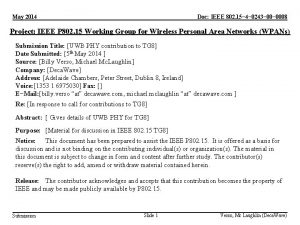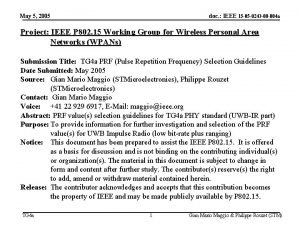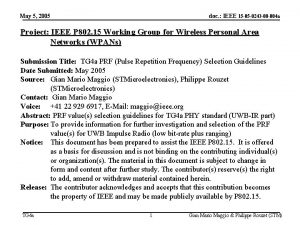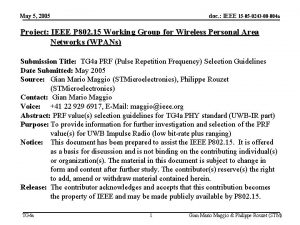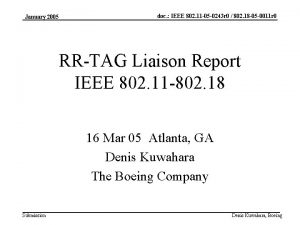May 2013 doc IEEE 802 15 13 0243








- Slides: 8

May 2013 doc. : IEEE 802. 15 -13 -0243 -01 Project: IEEE P 802. 15 Working Group for Wireless Personal Area Networks (WPANs) Submission Title: [Linear Technology Response to WG RFP on 4 e changes] Date Submitted: [16 April 2013 - revised format 14 May 2013] Source: [Jonathan Simon] Company [Linear Technology] Address [30695 Huntwood Ave, Hayward CA USA] Voice: [5104002936], FAX: [5104893799], E-Mail: [jsimon@linear. com] Re: [Changes to 4 e to support external SDO use - 15 -13 -0194 -01 -0 mag and 15 -13 -0220 -02 -0000 ] Abstract: [This document discusses the technical merits of the ETSI request to change 4 e IE encoding and ID space] Purpose: [Arguments against proposed amendments to IEEE 802. 15. 4 MAC] Notice: This document has been prepared to assist the IEEE P 802. 15. It is offered as a basis for discussion and is not binding on the contributing individual(s) or organization(s). The material in this document is subject to change in form and content after further study. The contributor(s) reserve(s) the right to add, amend or withdraw material contained herein. Release: The contributor acknowledges and accepts that this contribution becomes the property of IEEE and may be made publicly available by P 802. 15. Submission Slide 1 Jonathan Simon, Linear Technology

May 2013 doc. : IEEE 802. 15 -13 -0243 -01 Topic 1 – Need for additional frame identifiers • 3 -bit frame type space exhausted – suggestion to use last frame type (b 111) to signal that additional bits encode additional frame types – already implemented in ANSI/TIA-4957. 200 • Using the last frame type to signal additional information is backwards-compatible change and therefore acceptable • Note that the MAC header has historically been bytealigned. Changes that make the MAC header not be byte-aligned may make existing implementations unable to use the new format. • No opinion on whether some extended frame types should be reserved for other SDOs Submission Slide 2 Jonathan Simon, Linear Technology

May 2013 doc. : IEEE 802. 15 -13 -0243 -01 Topic 2 – Information Element Ranges • Complaint is that Unmanaged IE spaces are unworkable, as different vendors may choose the same IE to mean different things – they recommend policing ID space to ensure uniqueness. • Given that the unmanaged space is small, it is equally unworkable to restrict them to a particular vendor’s use. This would break existing implementations unless the ID’s already used are grandfathered in, and then there is no guarantee of uniqueness. We use several unmanaged header and payload IE’s in our product. • Far more managed but reserved ID’s exist, intentionally so that external SDO’s could bring valuable content to be standardized within those spaces. Submission Slide 3 Jonathan Simon, Linear Technology

May 2013 doc. : IEEE 802. 15 -13 -0243 -01 Topic 2 – Information Element Ranges (cont’d) • IEEE doesn't own the airwaves - anyone can send any set of bits they want at any time. Policing IE’s doesn’t prevent someone from sending a frame that a device might misinterpret • A properly designed top-level standard protocol uses security (particularly authentication) to distinguish its frames from those of other networks. Ability to reject unwanted frames is a basic security requirement. Colliding IE’s are no different than an attack – we don’t rely on IEEE policy to ensure that people won’t replay or spoof packets • Even without security, IE content inspection within the context of a particular network can help distinguish IE's with the same ID. This includes, but is not limited to, detecting ranges of acceptable values, IE length, the use of well-known field values (i. e. “Magic Numbers”), etc. Submission Slide 4 Jonathan Simon, Linear Technology

May 2013 doc. : IEEE 802. 15 -13 -0243 -01 Topic 3 – TLV encoding • Encoding of a Tag, length, and value (TLV) are represented as Length, Tag, Value (LTV) in a multi-bit field. This was a late change in the format, approved by the WG. • Changed at the request of Silver Spring Networks to facilitate migration of existing metering network designs – since it had little impact on implementation, it was accepted. • Parsing of this field is unambiguous and trivial to implement on most systems • Claims that memory and code complexity make this unworkable for low-power systems are hyperbole. We implemented this encoding on nodes that typically consume < 100 µW and can use as little as 20 µW in some configurations. Submission Slide 5 Jonathan Simon, Linear Technology

May 2013 doc. : IEEE 802. 15 -13 -0243 -01 Topic 3 – TLV encoding (cont’d) • Inconsistency with other standards on how the information is encoded in the over-the-air frame is irrelevant. Higher level service primitives are free to expose information in TLV or any other format (note that service primitives in the standard are conceptual interfaces, not byte-strict APIs). • Tying TLV changes to new frame types avoids breaking backward-compatibility with existing implementations if a particular SDO is unable to implement the existing format. Submission Slide 6 Jonathan Simon, Linear Technology

May 2013 doc. : IEEE 802. 15 -13 -0243 -01 Other considerations • Spec has been available for close to a year. There a number of products that are based on it, and IE’s are incorporated into 4 g and 4 f • Spec is implementable as written – these changes are about convenience, not technical barriers • ETSI personnel were involved in both TLV and IE formats, and contributed to the standard as written. Submission Slide 7 Jonathan Simon, Linear Technology

May 2013 doc. : IEEE 802. 15 -13 -0243 -01 Summary • Not opposed to Frame Identifier extensions as long as they are backwards compatible • Policing use of IE ID’s does not alleviate need for mechanisms to reject unwanted frames from other sources – suggest other mechanisms such as frame authentication or content filtering • IE TLV encoding is already used in the field, and doesn’t realistically represent a technical deficit that required re-writing a published standard. Submission Slide 8 Jonathan Simon, Linear Technology









